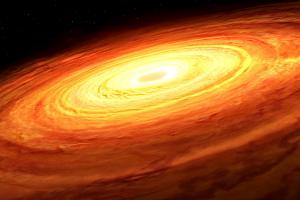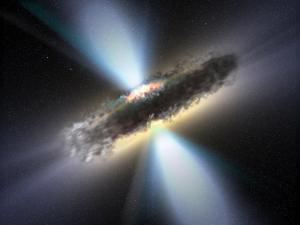Blog
Big Eater
18 August 2021
 Mark A. Garlick/Simons Foundation
Mark A. Garlick/Simons FoundationBlack holes don’t emit light, which makes them difficult to study. Fortunately, many black holes are loud eaters. As they consume nearby matter, surrounding material is superheated. As a result, the material can glow intensely, or be thrown away from the black hole as relativistic jets. By studying the light from this material we can study black holes. And as a recent study shows, we can even determine their size.1
Active supermassive black holes, also known as active galactic nuclei (AGN). Don’t simply shine with constant brightness. Their luminosity can change slightly over time. The timescale of this flickering can be anywhere from hours to years. Early studies have argued that this could be related to the size of the black hole, but the relationship isn’t always clear.
 ESA, V. Beckmann (GSFC)
ESA, V. Beckmann (GSFC)The basic idea is that the flickering is caused by an accretion disk around a black hole. The disk can be light-hours or light-days across. Since the speed of light is the maximum cosmic speed limit, that means overall changes in the disk will take at least hours or days. This works pretty well to tell you the maximum size of a black hole. For example, the rapid flickering of quasars tells us that they must be powered by black holes rather than some galaxy-spanning effect. But this doesn’t mean that AGNs flickering on a decade timescale are ten light-years across. Light speed is only an upper limit, and most effects propagate much more slowly.
In this new study, the team looked not at a simple flicker rate, but at the distribution of flicker rates known as the power spectrum density (PSD). They found that the scale at which the PSD levels off correlates to the size of the black hole. A particular black hole may have faster or slower flicker rates, but the overall distribution of flickers depends on the black hole mass. This is a much more reliable measure of size.
Interestingly, the team also applied their method to white dwarfs. These planet-sized solar mass stars can also have accretion disks, and the team found that their model applied to these accretion disks just as well. This suggests that the model describes something fundamental about accretion disks, not simply black holes. Because of this, the method could be applied to study elusive intermediate-mass black holes (IMBHs).
Intermediate mass black holes are the least understood type of black holes. They have masses of around 1,000 to 100,000 Suns and are typically found in dense globular clusters. When the Vera Rubin Observatory comes online, its sky survey could allow us to study the flickers of intermediate-mass black holes, and this method could tell us the mass distribution of IMBHs.
There are still aspects of the relation the team doesn’t fully understand. Further studies will look at how the rotation of a black hole or the magnetic field of the accretion disk might affect the relation. But already the tool can provide a good estimate of black hole size. At least when they happen to be big eaters.
Burke, Colin J., et al. “A characteristic optical variability time scale in astrophysical accretion disks.” Science 373.6556 (2021): 789-792. ↩︎